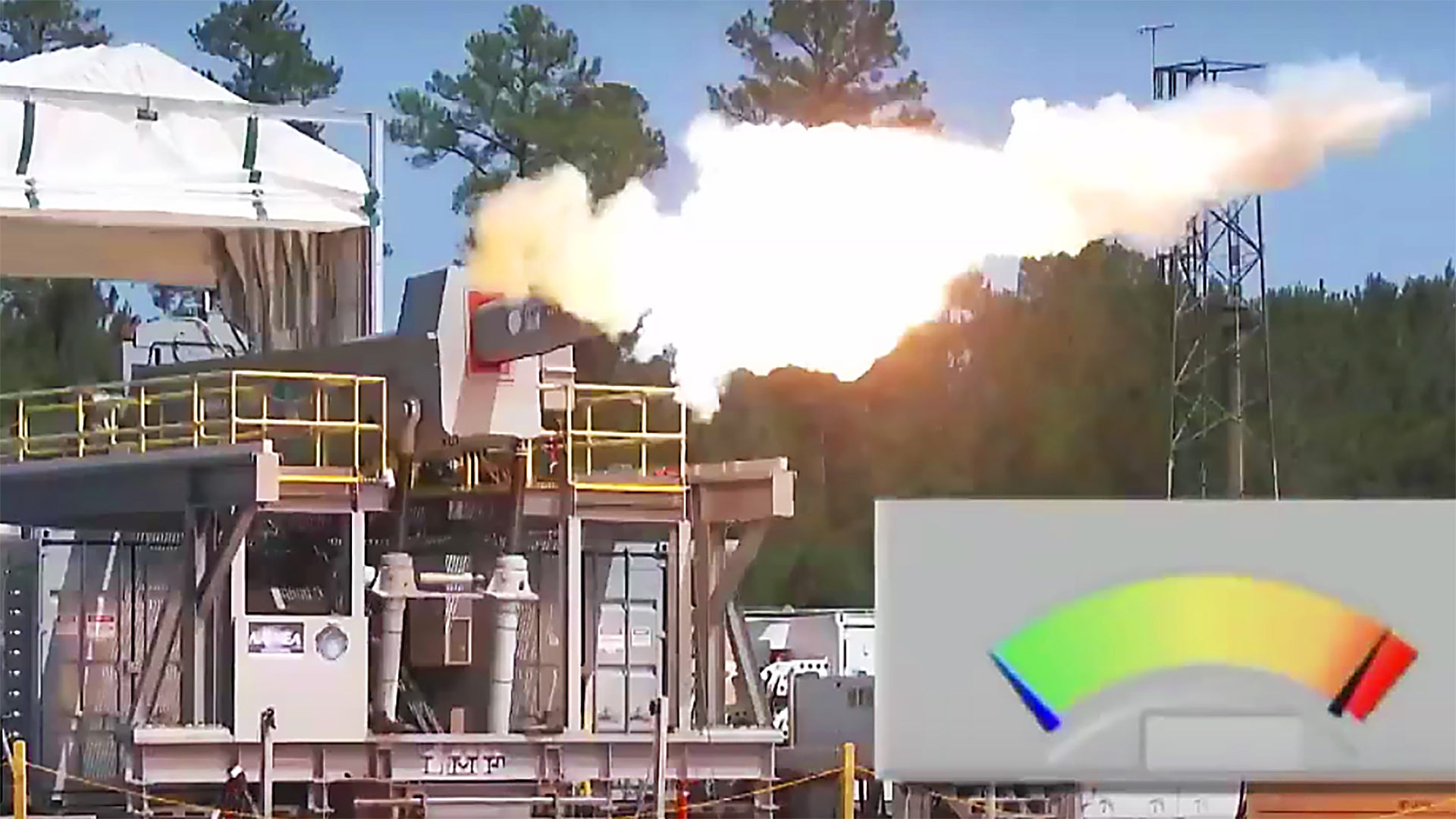The Navy’s electromagnetic (EM) railgun continues its development, with the Office of Naval Research publishing a video yesterday showing BAE Systems’ version firing off test shots in rapid succession with the help of the gun’s elaborate autoloading system.
The video was filmed at Naval Surface Warfare Center Dahlgren Division with the gun setup on a test gantry. We have seen this setup before, but the fact that the program is moving to mechanized rapid fire tests is a positive indication that the promising technology is indeed progressing toward an operational capability. Also, the video is another reminder of how cool this thing looks—a definite departure from deck guns of the past.

Railguns use a burst of electrical current to propel a projectile along a series of energized magnets to very high speeds, well over mach six. The system uses no traditional chemical charges, such as gunpowder. The Navy envisions future railguns as being able to sling rounds over 100 miles, not just a ground or sea targets, but also at aircraft, cruise missiles and ballistic missiles. You can read more about the railgun in this previous post.
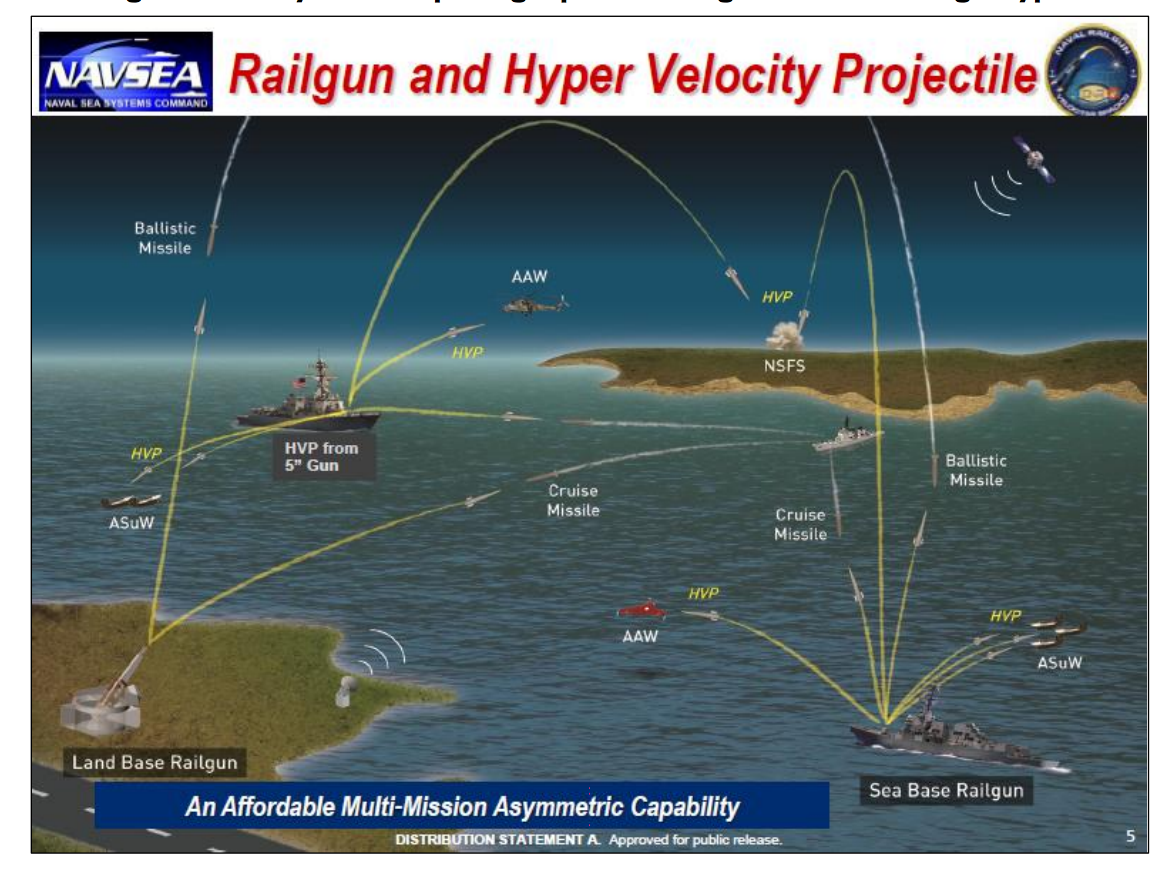
Following a detailed report on the Railgun’s progress from the Congressional Research Service, the Navy appears set to start equipping its surface combatants with the weapon in an operational form within the next decade. Not only will the weapon open up new tactical possibilities, but two of its greatest features are cost-exchange ratio and magazine depth.
Both of these factors have more to do with the railgun’s use as a defensive weapon than as an offensive one. The CRS report states:
“Two key limitations that Navy surface ships currently have in defending themselves against ASCMs and ASBMs are limited depth of magazine and unfavorable cost exchange ratios. Limited depth of magazine refers to the fact that Navy surface ships can use surface-to-air missiles(SAMs) and their Close-in Weapon System (CIWS) Gatling guns to shoot down only a certain number of enemy unmanned aerial vehicles (UAVs) and anti-ship missiles before running out ofSAMs and CIWS ammunition—a situation (sometimes called “going Winchester”), that can require a ship to withdraw from battle, spend time traveling to a safe reloading location (which can be hundreds of miles away), and then spend more time traveling back to the battle area.
Unfavorable cost exchange ratios refer to the fact that a SAM used to shoot down a UAV or anti ship missile can cost the Navy more (perhaps much more) to procure than it cost the adversary to build or acquire the UAV or anti-ship missile. In the FY2018 defense budget, procurement costs for Navy SAMs range from about $976,000 per missile to several million dollars per missile, depending on the type.
In combat scenarios against an adversary with a limited number of UAVs and anti-ship missiles, an unfavorable cost exchange ratio can be acceptable because it saves the lives of Navy sailors and prevents very expensive damage to Navy ships. But in combat scenarios (or an ongoing military capabilities competition) against a country such as China that has many UAVs and anti ship missiles and a capacity for building or acquiring many more, an unfavorable cost exchange ratio can become a very expensive—and potentially unaffordable—approach to defending Navy surface ships against UAVs and anti-ship missiles, particularly in a context of constraints on U.S.defense spending and competing demands for finite U.S. defense funds.SSLs, EMRG, and HVP offer a potential for dramatically improving depth of magazine and the cost exchange ratio:
Depth of magazine: SSLs are electrically powered, drawing their power fromthe ship’s overall electrical supply, and can be fired over and over, indefinitely, aslong as the SSL continues to work and the ship has fuel to generate electricity.The EMRG’s projectile and the HVP (which are one and the same—see nextsection) can be stored by the hundreds in a Navy surface ship’s weaponmagazine.
Cost exchange ratio: An SSL can be fired for a marginal cost of less than one dollar per shot (which is the cost of the fuel needed to generate the electricity used in the shot), while the EMRG’s projectile/HVP has an estimated unit procurement cost of about $25,000″
The use of the railgun for defensive purposes is likely the realm in which it will be tested first, and being able to fire multiple shots in relatively quick succession will be a key aspect of this capability.
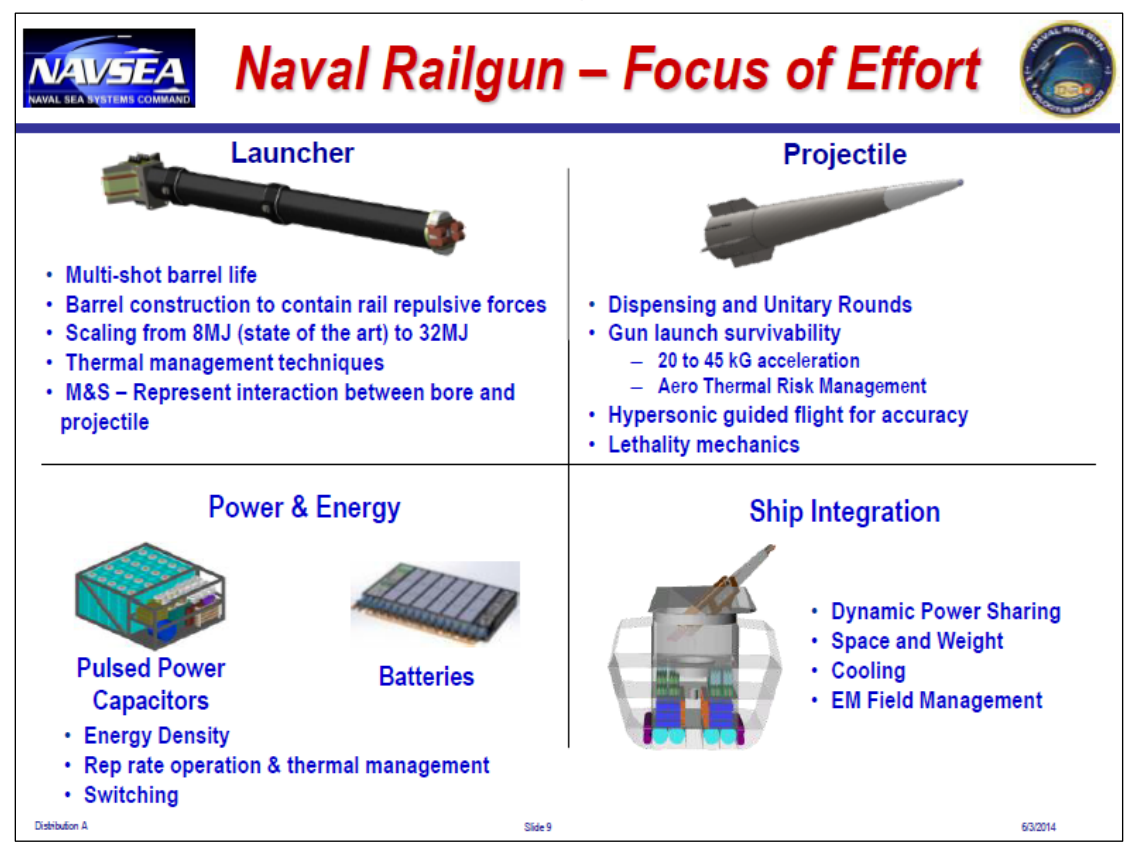
Both BAE Systems and General Atomics are now working on evaluating what barrel configurations will be best for achieving a five shots per minute minimum goal. The aim is for BAE to deliver its prototype Railgun to the Navy sometime in 2018, while General Atomics is eyeing tests against cruise missile-like targets in 2018 at Utah’s Dugway Proving Grounds. BAE’s version is still planned to be setup on one of the Navy’s Spearhead class fast logistics ships for tests, although exactly when those tests will take place is unclear.
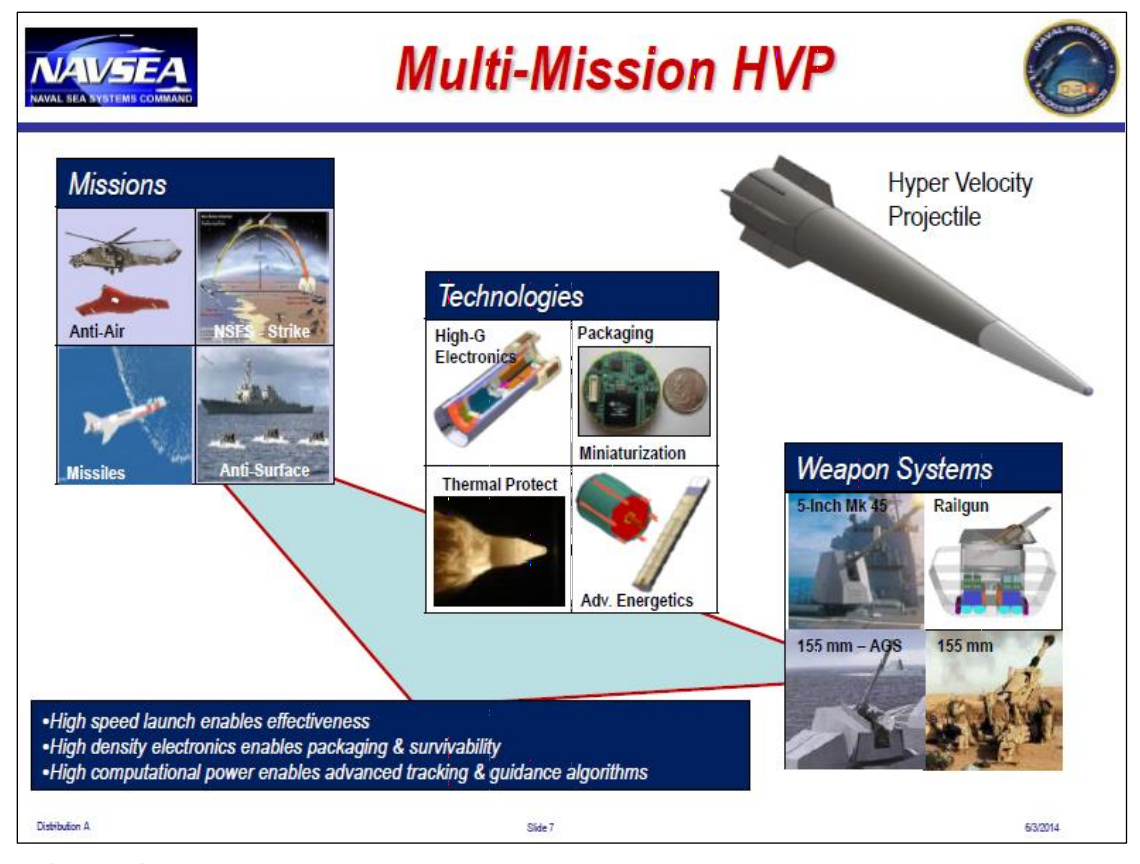
At the same time, the spike-like Hypervelocity Projectile (HVP), the Railgun’s primary ammunition, is also finding extreme interest from other “big gun” programs that use gunpowder instead of massive surges of electromagnetic energy for propellant. Migrating the HVP to more traditional fire support systems, like theM777 Howitzer and the Navy’s Mark 45 5 inch gun, will open up new tactical possibilities for these weapons, and it would do so likely in a much smaller developmental timeline than fielding the railgun as the inaugural platform for the munition.
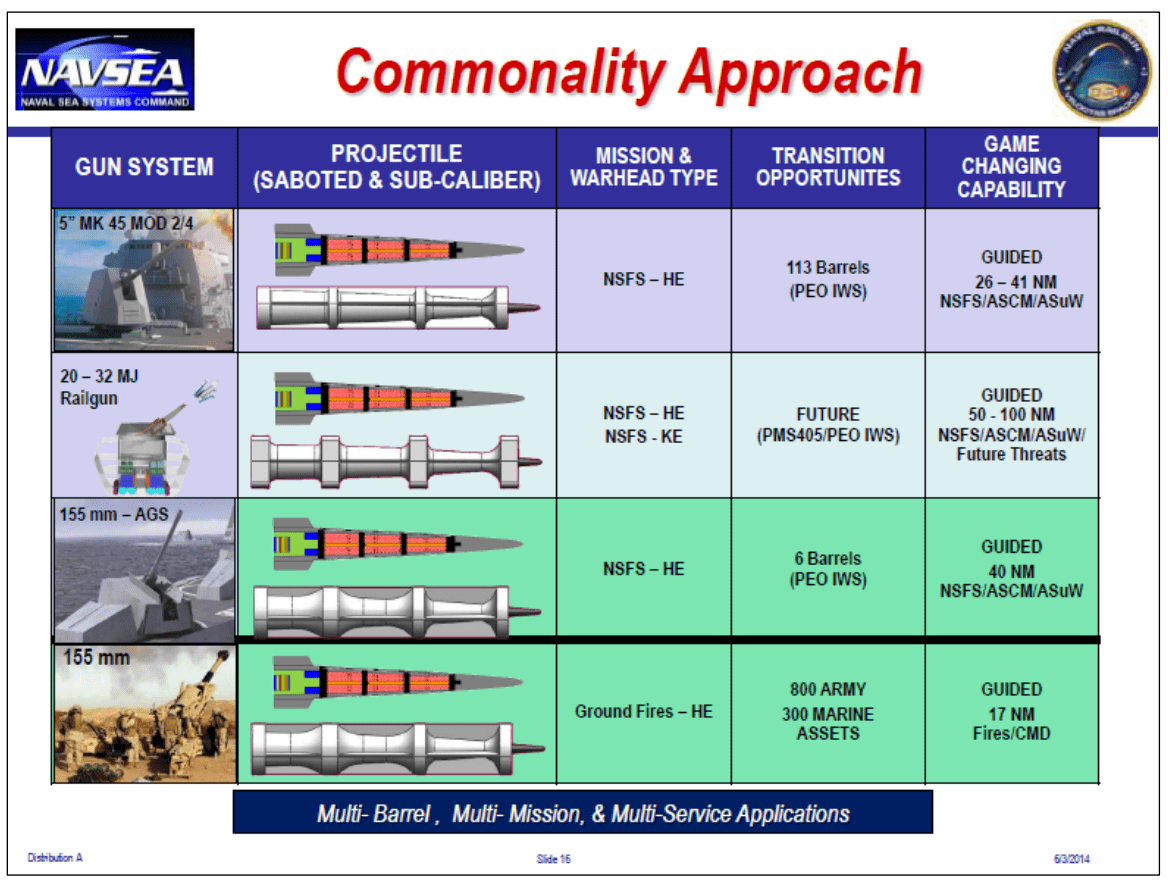
Whether the HVP is propelled using gunpowder or electricity, fielding it operationally could lead to entirely new missions for existing gun systems and the advent of entirely new gun systems altogether. It isn’t that hard to imagine Marines setting up a firebase with their usual Howitzers and a turreted gun system that is tied into mobile counter-battery and air defense radar systems. Both guns can use the same HVP ammunition, but the turreted gun would be capable of blasting everything from drones to incoming ballistic missiles and artillery out of the sky.

Getting HVP on the menu of multiple gun systems will also lower the unit cost of each projectile, and will lead to faster evolution and growth for the munition and their applications overall.
Contact the author: Tyler@thedrive.com
